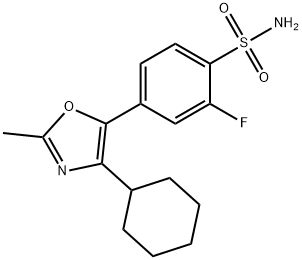180200-68-4
 180200-68-4 結(jié)構(gòu)式
180200-68-4 結(jié)構(gòu)式
基本信息
化合物 T15630
RWJ57504
JTP19605
Tilmacoxib
Benzenesulfonamide, 4-(4-cyclohexyl-2-methyl-5-oxazolyl)-2-fluoro-
4-(4-cyclohexyl-2-methyl-1,3-oxazol-5-yl)-2-fluoro-benzenesulfonamide
物理化學(xué)性質(zhì)
| 報價日期 | 產(chǎn)品編號 | 產(chǎn)品名稱 | CAS號 | 包裝 | 價格 |
| 2024/11/08 | HY-U00197 | 4-(4-cyclohexyl-2-methyl-1,3-oxazol-5-yl)-2-fluoro-benzenesulfonamide Tilmacoxib | 180200-68-4 | 1mg | 8000元 |
常見問題列表
|
Human COX-2 85 nM (IC 50 ) |
Inhibitory activity and the mechanism of action of Tilmacoxib (JTE-522), a novel selective cyclooxygenase (COX)-2 inhibitor, on human COX-1 and COX-2 are investigated and compared with those of reference compounds. In an enzyme assay, Tilmacoxib inhibits yeast-expressed human recombinant COX-2 with an IC 50 of 0.085 μM. In contrast, Tilmacoxib does not inhibit human COX-1 prepared from human platelets at concentrations up to 100 μM. In a cell-based assay, Tilmacoxib diminishes lipopolysaccharide-induced prostaglandin E2 production in human peripheral blood mononuclear cells (COX-2) (IC 50 =15.1 nM). On the other hand, Tilmacoxib is less potent at inhibiting calcium ionophore-induced thromboxane B2 production in washed human platelets (COX-1) (IC 50 =6.21 μM). Tilmacoxib shows highly selective inhibition of human COX-2, and its activity is more selective than that of other COX-2 inhibitors (NS-398 and SC-58635). Human recombinant COX-2 activity is attenuated by Tilmacoxib in a dose-dependent and time-dependent manner. Inhibition of proliferation of gastric epithelial cells by a cyclooxygenase 2 inhibitor, Tilmacoxib (JTE522), is also mediated by a PGE 2 -independent pathway Combination of Tilmacoxib and Arachidonic acid results in a marked retardation of wound healing compared to the control, but Tilmacoxib does not completely suppress the increase in cellular PGE 2 content following the addition of arachidonate.
The present experiment is designed to assess the potential chemopreventive properties of Tilmacoxib (JTE-522), a new selective cyclooxygenase-2 inhibitor, on the induction of 1,2-dimethylhydrazine (DMH)-induced colonic aberrant crypt foci (ACF), a marker of rat colon carcinogenesis. A total of 80 male F344 rats are treated with 3 or 10 mg/kg of body weight Tilmacoxib or vehicle by oral gavage five times weekly from the start of the experiment. One week later, rats receive s.c. injections of saline or 20 mg/kg of body weight DMH once weekly for four successive weeks. At the end of 12 weeks after the start of experiment, all rats are sacrificed and colons are evaluated for ACF. 10 mg/kg Tilmacoxib significantly suppresses the total ACF/colon. No inhibitory effect is observed in the 3 mg/kg Tilmacoxib treatment group. Administration of 10 mg/kg Tilmacoxib significantly suppresses ACF formation with a 30% reduction in total ACF/colon (p<0.01). Furthermore, the data on crypt multiplicity show that 10 mg/kg Tilmacoxib significantly reduces the formation of foci containing 1-3 crypts but not foci containing four crypts or more. Administration of the low dose of Tilmacoxib (3 mg/kg) has no inhibitory effects on either the total ACF or crypt multiplicity.
